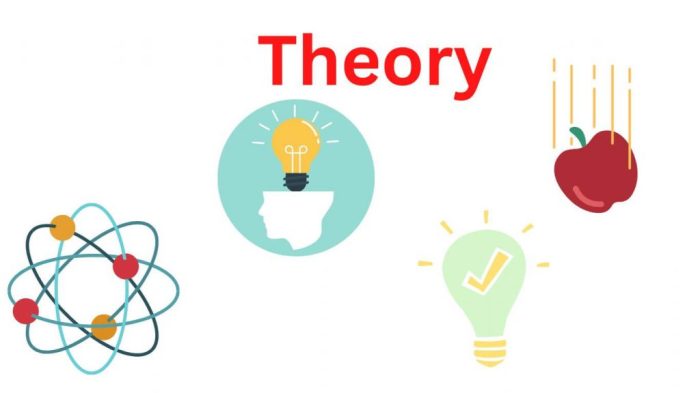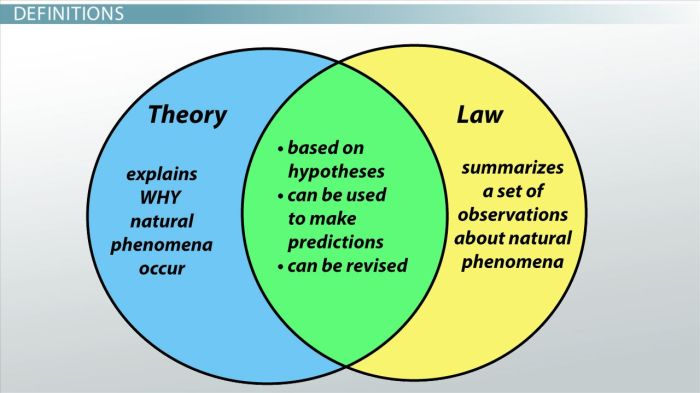
What is the difference between a theory and a law – What’s the difference between a theory and a law sets the stage for a fascinating exploration into the heart of scientific understanding. While both theories and laws play crucial roles in explaining the natural world, they differ significantly in their scope, nature, and development. This exploration will delve into the nuances of these concepts, unraveling the intricate web of scientific inquiry and discovery.
In the realm of science, “theory” and “law” are often used interchangeably, leading to confusion. However, these terms have distinct meanings and represent different levels of scientific understanding. A scientific theory is a well-substantiated explanation of some aspect of the natural world that can incorporate facts, laws, inferences, and tested hypotheses. In contrast, a scientific law is a statement based on repeated experimental observations that describes some aspect of the universe and can be expressed mathematically. Think of a theory as a grand narrative, a comprehensive explanation of a phenomenon, while a law is a specific rule or principle that governs that phenomenon.
Definitions

In the realm of science, understanding the distinction between a theory and a law is crucial for grasping the nature of scientific knowledge. While both terms are often used interchangeably in everyday language, they carry distinct meanings within the scientific community.
Scientific Theories
A scientific theory is a well-substantiated explanation of some aspect of the natural world that can incorporate facts, laws, inferences, and tested hypotheses. It is a comprehensive and coherent framework that aims to explain a wide range of phenomena. Theories are supported by a substantial body of evidence, including experimental results, observations, and data analysis.
A scientific theory is a well-substantiated explanation of some aspect of the natural world that can incorporate facts, laws, inferences, and tested hypotheses.
Theories are not mere guesses or speculations but rather rigorously tested and refined explanations. They are constantly being evaluated and refined as new evidence emerges. Theories can be modified or even replaced if new data contradicts them.
Scope and Applicability

Theories and laws differ significantly in their scope of application and the extent to which they can explain natural phenomena. While laws describe consistent patterns in nature, theories offer broader explanations for these patterns.
Scope of Application
Theories and laws differ in their scope of application.
- Laws are typically limited to specific phenomena and often expressed mathematically. For instance, Newton’s Law of Universal Gravitation describes the force of attraction between any two objects with mass. This law applies only to the interaction of objects with mass, not to other forces or phenomena.
- Theories, on the other hand, encompass a wider range of phenomena and provide a framework for understanding a broader set of observations. For example, the Theory of Evolution by Natural Selection explains the diversity of life on Earth through a process of gradual change over time. This theory encompasses various biological processes and provides a framework for understanding the evolution of species.
Limitations of Theories and Laws, What is the difference between a theory and a law
Theories and laws have limitations in their ability to explain all natural phenomena.
- Laws are often based on specific conditions and may not hold true in all situations. For instance, Newton’s Law of Universal Gravitation accurately describes the gravitational force between objects at relatively low speeds and distances. However, it breaks down when dealing with extremely massive objects or speeds close to the speed of light, where Einstein’s theory of general relativity provides a more accurate explanation.
- Theories are constantly being refined and updated as new evidence emerges. The Theory of Evolution, for example, has been modified and expanded since Darwin’s initial proposal, incorporating new discoveries in genetics and molecular biology. While theories provide valuable frameworks for understanding the world, they are not absolute truths and can be subject to revision as our understanding of the natural world evolves.
Nature of Evidence: What Is The Difference Between A Theory And A Law
Theories and laws are not simply ideas or pronouncements; they are built upon a foundation of evidence. This evidence comes from various sources and takes different forms, playing a crucial role in shaping our understanding of the natural world.
Evidence is the cornerstone of scientific inquiry. It provides the foundation for developing, refining, and validating theories and laws. The type of evidence used varies depending on the specific theory or law being investigated, but generally falls into two main categories: observational and experimental.
Observational Evidence
Observational evidence is gathered through careful observation of the natural world. This can include:
- Direct observation of phenomena, such as observing the movement of planets in the sky or the behavior of animals in their natural habitat.
- Analysis of data collected through instruments, such as telescopes, microscopes, and weather stations.
- Examination of fossils, geological formations, and other traces of past events.
Observational evidence provides valuable insights into the patterns and relationships that exist in the natural world. It can help scientists to formulate hypotheses and theories, and to identify potential areas for further investigation.
Experimental Evidence
Experimental evidence is gathered through controlled experiments designed to test specific hypotheses. This involves:
- Manipulating variables in a controlled environment to observe the effects on a particular phenomenon.
- Collecting and analyzing data from the experiment to draw conclusions about the relationship between the variables.
- Repeating the experiment multiple times to ensure the results are consistent and reliable.
Experimental evidence provides strong support for theories and laws by demonstrating cause-and-effect relationships. It allows scientists to isolate and study specific factors, providing a more precise understanding of the underlying mechanisms.
Examples of Evidence Refinement
The nature of evidence is dynamic. As new data is collected and analyzed, theories and laws can be refined or even overturned. Here are some examples:
- The discovery of new fossils has led to significant revisions in our understanding of the evolution of life on Earth.
- The development of new technologies, such as the Hubble Space Telescope, has provided evidence that has challenged existing theories about the origin and evolution of the universe.
- The discovery of the planet Neptune was based on the observation of irregularities in the orbit of Uranus. This led to the refinement of Newton’s law of gravitation to account for the gravitational influence of Neptune.
Final Wrap-Up

Understanding the distinction between scientific theories and laws is crucial for appreciating the dynamic nature of scientific knowledge. Theories, with their broader power, are constantly evolving and being refined as new evidence emerges. Laws, on the other hand, remain steadfast, providing fundamental principles that govern the universe. By embracing both theories and laws, we gain a deeper understanding of the natural world, acknowledging the ongoing process of scientific discovery and the interconnectedness of knowledge within the scientific community.
Frequently Asked Questions
Why are some theories called “theories” and not “laws”?
Theories are broader explanations that encompass a wider range of phenomena, while laws are more specific statements that describe a particular relationship. Theories are often more complex and require more evidence to support them. Think of a theory as a framework for understanding a complex system, while a law is a specific rule within that framework.
Can a theory become a law?
No, a theory cannot become a law. Theories and laws serve different purposes in science. Theories provide explanations, while laws describe patterns. A theory can be supported by a law, but a law does not become a theory.
What is the difference between a hypothesis and a theory?
A hypothesis is a testable prediction, while a theory is a well-substantiated explanation supported by evidence. A hypothesis is a starting point for scientific inquiry, while a theory is the result of extensive research and testing.
Are there any theories that have been proven to be true?
Scientific theories are not “proven” to be true in the absolute sense. Instead, they are supported by a vast body of evidence and have withstood rigorous testing. Theories can be modified or replaced as new evidence emerges, but they are never considered “proven” in the final sense.





